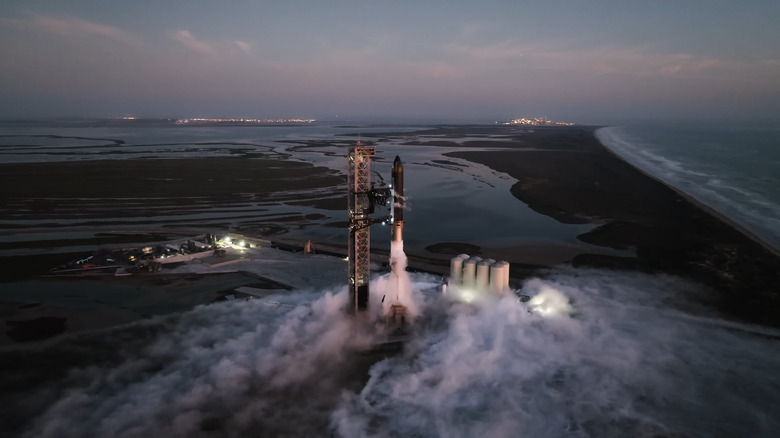Why SpaceX Catching Starship Will Change Everything About Space Travel
It isn't a secret that SpaceX has big plans for Starship, its massive mega-rocket, which has so far seen five test flights since April of last year. As the largest rocket ever created, Starship is a behemoth that will play a vital part in the ongoing endeavors to send humanity to other planets. This past weekend, SpaceX completed the first of hopefully many Starship booster catches, and that will change everything about the future of space travel.
Starship has had a bit of a rocky journey since its first launch ended in a mid-flight explosion. Since then, SpaceX has worked out some of the kinks and completely four additional test flights, with the latest flight taking place on Sunday, October 13. While the second, third, and fourth flights were impressive in their own rights—and all "successes," according to SpaceX CEO Elon Musk, this fifth flight did something different.
This time around, SpaceX endeavored to catch the Starship rocket booster as it fell to the ground. But, instead of simply letting it land autonomously on a boat out at sea, SpaceX upped the ante a bit, having the tower that Starship launched off catch the booster in a series of mechanical arms. This showcases a huge feat that will completely change the face of human space travel going forward.
The tower has caught the rocket!!
pic.twitter.com/CPXsHJBdUh— Elon Musk (@elonmusk) October 13, 2024
Now, that might just sound like buzzwords, and to be honest, with any other company out there, it probably would be. But SpaceX has consistently shown a renewed vigor for space travel and innovation when it comes to successes like this. And being able to catch the booster for a massive rocket like Starship right at the pad where it took off is going to save a lot of travel time to get it back where it needs to be to be ready for another launch.
This could mean quicker launches than we're currently seeing from the Starship rockets, which would allow for more missions beyond the usual scope. This kind of thing would prove especially useful for NASA's Artemis missions, which will rely on a version of Starship to deliver astronauts back to the Moon for the first time since the 1970s. With a more effective catch system for the Starship boosters, SpaceX could theoretically outperform NASA's current SLS system, which has already proven to be costly and cumbersome.
But this isn't exactly a new idea, either. SpaceX has been catching the boosters for some of its other rockets for roughly nine years now. While those catches are impressive, they're usually done out at sea, as I mentioned above, or on concrete slabs miles away from the launch pad. This time around, though, SpaceX performed the feat directly over its launch pad. Which severely cuts down the time needed to recover the booster.
And with Starship also set to play a part in SpaceX's plans to eventually put humans on Mars, being able to catch the Starship boosters would hopefully allow for more timely missions—perhaps even paving the way for weekly launches at some point.
